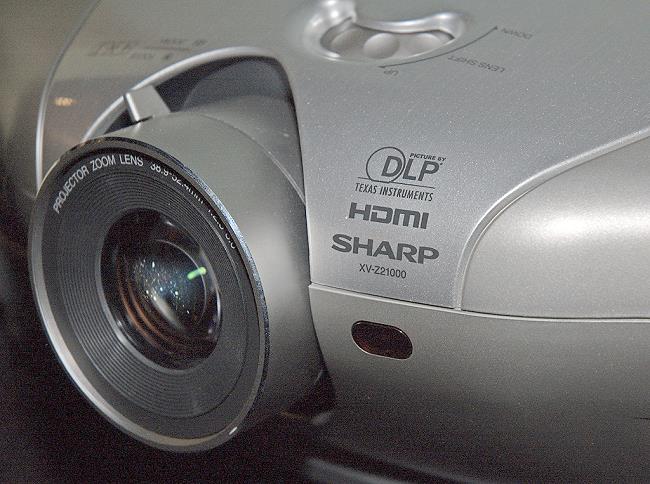Introduction
I remember the first time I laid eyes on the
Sharp XV-Z12000U. I was astonished at the amazing image, a dramatic step
beyond any consumer home theater projector I'd seen up until that point. At
the same time, I remember the adverse effects of DLP and how, an hour
afterwards, I still had a slight headache from the experience.
I had a similar experience when I first saw the the Sharp XV-Z21000. The
XV-Z21000 is the European version of the XV-Z20000 (the US version). They
are virtually identical.
This is the
first 1080p single-chip DLP projector I have had the opportunity to test (The
Sony VPL-VW50 is a three-chip SXRD projector).
The Z21000 uses a 5X color wheel with a non-dynamic
(but multi-step) iris with a particularly high contrast ratio at 12,000:1. A
lot of promise, but does this projector really deliver?
The big benefit of DLP over other production ready technologies is high
contrast. Whereas LCD and LCoS/SXRD/DILA projectors need one or two irises
to reach a contrast of 10,000:1 or higher, DLP projectors can now reach this
level without a dynamic iris.
While this might not seem like much, it really does make a difference in
real life content. A dynamic iris, even in the best of cases, cannot show
high levels of detail when there are both bright and dark areas. It does a
lot better when the majority of the screen is either dark (so the iris can
close and less light comes out of the projector) or bright (the iris opens).
Projectors with one or two irises (one before the panels and one after) tend
to have white and dark detail compression. That means that a person with
dark cloths standing in a well lit room, might not have all the details of
his clothes show up in full. The blacks are blacker only when the scene is
dark, and the whites are whiter only when the scene is bright. This Dynamic
Contrast is not the same as Frame Contrast, which means the contrast in an
individual movie frame . . . a single static image. This is indicated by the
ANSI contrast ratio, which is a series of black and white squares on a
single test pattern. The dynamic iris is useless here.
The XV-Z21000
This projector outputs 1,000 lumens, which is medium
brightness these days. It has vertical lens shift, as seen in the photo
below.

A few words about the remote control. This is, hands
down, the most feature-complete remote I can imagine. Every necessary
feature is there, discrete buttons for each input and separate on/off
buttons make it just perfect. It sits perfectly in my hand. Sharp could not
improve on it if they tried.

The Sharp XV-Z21000 has a very high ANSI contrast
ratio. That means it can easily show both bright and dark details, in the
same scene, without any compression or loss of detail. You would be
surprised at how many scenes actually have this effect and you can't fully
appreciate how well a high ANSI-contrast projector can perform until you see
such images.
I'll start by saying that the Z21000 caused my jaw to drop repeatedly while
watching both familiar and unfamiliar test content. But, before I could
really enjoy the projector, I had to calibrate it. Given the time
constraints, I could not do a full blown calibration. The results should be
much better with an hour or two more of work.
At this point, I began the measurements and got an
unbelievable 16,000:1 Full On/Off CR in high contrast mode! I was so
flabbergasted, I actually measured this twice. I would say that the actual
number is probably not as high, given that this exceeds my sensor's
specifications.
I used an Accupel test pattern generator to try and first map the source to
native rate. This projector defaults to about 5% overscan, and this should
be immediately removed if a proper 1080p source is used. Another thing I
didn't really like was the Brilliant Color feature that tends to make colors
a lot more lively, but they end up a lot less realistic.
Once the overscan has been adjusted, I started doing some frequency checks
and the projector passed with flying colors. I also got a 92% brightness
uniformity, which was very good - no visible hot spotting that I could see.
After getting a reasonable calibration, I proceeded to see if I could see
any dithering. Some was visible on the low IREs, but only when a full screen
pattern was used.
Using the convergence patterns, I was able to see one pixel of vertical
offset. This is surprising, since a single-chip DLP should not have any
visible convergence issues at all. I would assume that this is some type of
optical aberration and could very well be specific to this particular
projector.
Once in this pattern, rainbows galore. It was hard
seeing anything at all beyond the rainbows. On normal material, I had to
press myself hard to see any rainbows.
From a short distance, the SDE (Screen Door Effect) was quite visible. The
fill factor here is lower than some projectors like the Panasonic AE900 LCD
projector, or the JVC HD2K LCoS projector. However, from a normal viewing
distance, the SDE was invisible.
During calibration, I decided to keep the unit set at a gamma of 2.02. This
might seem low, because typical SD viewing entails 2.2 gamma, while HD
content usually looks better with a higher gamma. Low gamma usually means
the picture is too milky and too many dark details show up too brightly.
On this projector, however, the picture not only
didn't seem washed out, milky, or artifact-ridden, it was practically
perfect. The high intrinsic panel contrast just looked great, and a higher
gamma seemed to hide details without really making the picture look any
better.
Click Here to Go to Part II.